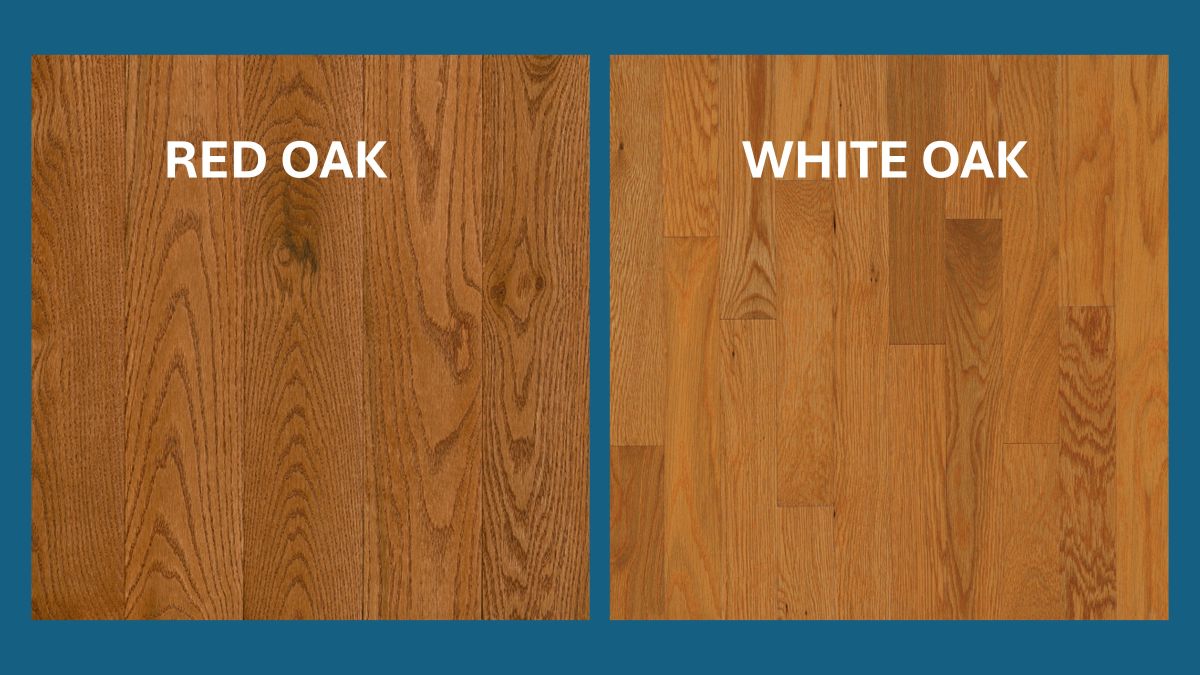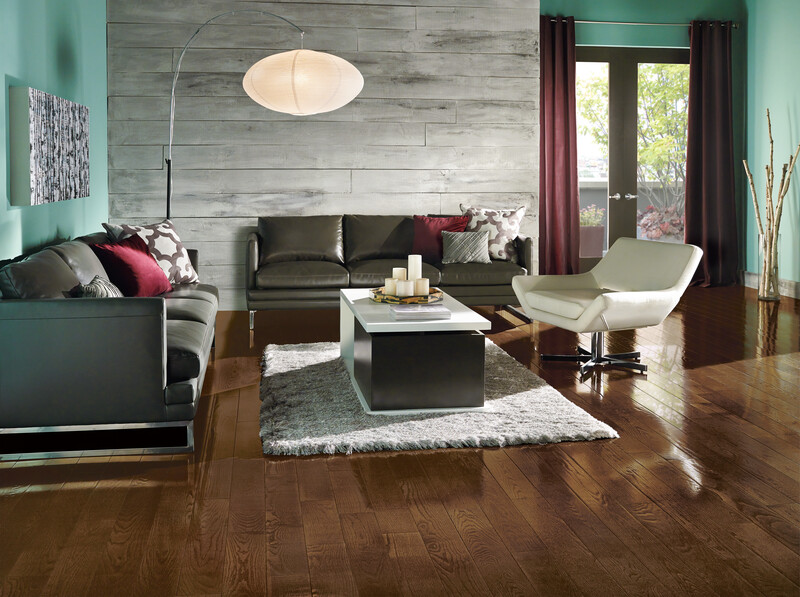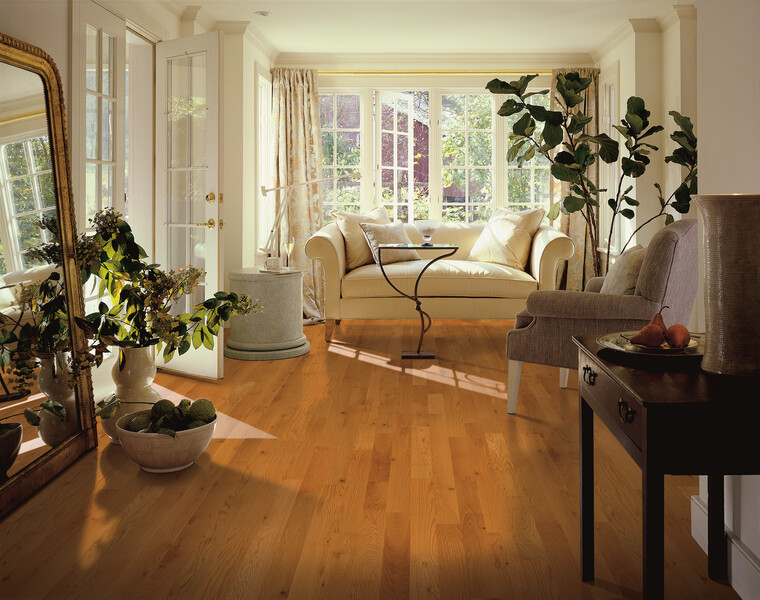Red Oak vs White Oak Flooring – Which to Choose
May 7, 2025
Red oak vs. white oak flooring — it can feel like splitting hairs. That is, until you understand how different these two oak hardwood species are. Each offers unique advantages, from color and grain patterns to durability, cost, and water resistance.
Knowing the critical differences between red and white oak can help you make the right call for your home. Let’s dig in and help you make the best choice for your space.

Essential Differences Between Red Oak and White Oak Flooring
Both red and white oak are popular hardwood species for flooring in the United States. Indeed, oak flooring is generally the most popular choice among American homeowners.
They’re durable, timeless, and versatile. However, their physical characteristics make their differences easy to spot once you know what to look for.
Red Oak Flooring
Red oak flooring is an excellent fit for traditional and transitional homes. Its active grain and warmer tone give it a classic, welcoming feel. Red oak also easily accepts a wide range of stain colors, so it works well with custom finishes and lighter stains or bold tones.
These are some of red oak’s essential traits:
- Color: Warm undertones with a pink or reddish hue
- Grain: More pronounced and varied grain patterns
- Texture: Slightly more porous than white oak, stains well
- Density: Durable, but less dense than white oak
- Price: Generally more affordable

White Oak Flooring
White oak flooring offers a neutral, clean look perfect for modern, minimalist, and Scandinavian-inspired interiors. It also handles moisture and wear better than red oak, making it a better fit for kitchens, high-traffic areas, and entryways.
- Color: Cooler tones with tan, beige, or grayish undertones
- Grain: Straighter, more uniform grain pattern
- Texture: Closed grain, naturally more moisture resistant
- Density: Harder and more durable than red oak
- Price: Slightly higher because of performance characteristics
Where to Use Red and White Oak
Beyond aesthetics, choosing between red oak and white oak depends on how and where you’ll be using the floor.
Choose white oak flooring for:
- High-traffic areas: White oak performs with a higher Janka scale rating.
- High-moisture zones: White oak’s closed grain offers better water resistance.
Choose red oak flooring for:
- Budget-conscious renovations: Red oak gives solid performance at a more affordable price.
- Custom stain jobs: Red oak takes stains more readily, especially lighter ones.
Solid vs. Engineered Red and White Oak
When choosing between red oak and white oak flooring, it’s not just about color and grain—it’s also about format. The type of construction you choose can impact where you install the floor, how it performs under pressure, and how long it lasts.
Understanding the strengths of solid and engineered hardwood formats will help you make the right choice for your space and lifestyle.
Solid Oak Flooring
- Best for above-grade areas
- Can be refinished multiple times over decades
- Highlights the natural grain of red and white oak
Engineered Oak Flooring
- Ideal for basements and moisture-prone spaces
- Greater dimensional stability
- Available in a variety of finishes, widths, and surface textures
Cost of Red Oak vs White Oak Flooring
Cost is often a key factor when choosing between red and white oak.
Thanks to its wider availability, red oak tends to be more affordable. That makes it an excellent choice for large projects or homeowners within a strict budget.

White oak costs a bit more. However, the added expense comes with benefits like improved water resistance and durability. It’s often a better long-term investment, particularly in high-traffic areas or homes with pets and kids.
Here’s a breakdown of typical costs:
Red Oak Flooring
- Material Costs: Red oak flooring typically ranges from $3 to $11 per square foot, depending on the grade and finish.
- Installation Costs: Professional installation can add $3 to $7 per square foot, totaling $6 to $18 per square foot.
White Oak Flooring
- Material Costs: White oak flooring generally costs $4 to $12 per square foot, reflecting its higher density and popularity.
- Installation Costs: The total cost of installation ranges from $7 to $19 per square foot.
These prices vary based on plank width, finish, and regional labor rates. Wider planks or specialty finishes can increase the cost.
For a more detailed breakdown and additional information, visit HomeAdvisor’s Oak Flooring Cost Guide.
Red Oak vs. White Oak for Color, Grain, and Stain
Design preference plays a substantial role in your decision. Once stained, red oak and white oak look and behave differently. White oak is ideal for a calm, uniform look, while red oak wins for movement and texture.
- Red oak shows more contrast in grain patterns and color variation. It works well with medium to dark stain colors.
- White oak’s closed grain gives it a smoother appearance and better accepts neutral and gray stains.
Matching stain color to furniture, cabinetry, or existing trim is easier when you factor in each wood’s natural tones. Consider testing sample boards side-by-side to see how your preferred stain reacts with red and white oak.
Sustainability and Availability of Red and White Oak
Red and white oak are sourced domestically, making them environmentally friendly hardwood flooring choices. Red oak is more abundant, which contributes to its lower price. White oak grows slightly slower, and its higher density increases production costs.
Choosing Between Red Oak and White Oak
Red oak and white oak each bring something valuable to the table. Red oak is warm, character-rich, and budget-friendly. White oak is sleek, resilient, and trending in today’s interiors.
Hartco® offers roughly 200 selections of white oak and red oak flooring. You can select from solid and engineered hardwoods. Plus, there’s an excellent selection of finish types, including traditional, distressed, wire-brushed, and hand-scraped wood. You can also select various widths.
Classic or contemporary, light and airy or deep and dramatic—find the oak hardwood flooring that fits your home and your life. Find a Hartco retailer near you and enjoy the enduring quality of red and white oak flooring.

FAQ: Red Oak vs White Oak Flooring
Is red oak or white oak better for moisture resistance?
White oak. Its closed grain makes it more resistant to water penetration and better suited for kitchens, bathrooms, and entryways.
Which has a harder surface, red or white oak?
White oak. It scores higher on the Janka scale, meaning it’s more resistant to dents and scratches.
What are the disadvantages of white oak?
White oak is more expensive and, with its tight grain, can be harder to stain consistently. Matching existing finishes may require more testing.
Can red oak mimic white oak with the right stain?
To an extent, yes. But red oak’s pinkish undertones can peek through lighter stains. For a truly cool-toned floor, white oak is the better choice.
Which is better for resale value, red oak or white oak?
Both are respected hardwood species. However, white oak’s growing popularity in modern design may give it a slight edge with today’s buyers.
